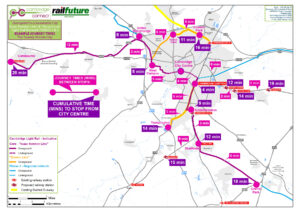Cambridge Light Rail would provide people with short journey times on a rapid transit system. Based on an average speed of 33 kph (London Tube, Transport for London) including stops the proposed routes could move people across Cambridge astonishingly quickly. (A faster average speed of 60 kph has been used where the light rail line goes through rural areas).
Journey times
Cambridge Connect has calculated typical journey times between example stops if all options for the Cambridge Light Rail line were implemented. For example:
- Cambridge Central Station to Market Square: 4 mins!
- Cambridge Central Rail Station to Addenbrookes: 5 mins
- Cambridge Central Rail Station to West Campus: 9 mins.
- West Campus to central city: 5 mins.
- West Campus to Cambridge Central Rail Station: 9 mins.
- West Campus to Addenbrookes: 14 mins.
- West Campus to Science Park: 11 mins.
- Histon Road to Cambridge City: 14 mins.
- Cambourne to West Campus: 15 mins.
- Cambourne to Cambridge City: 20 mins.
- Granta Park to Addenbrookes: 9 mins.
- Granta Park to Cambridge City: 18 mins.
The journey times are much faster than by car, more reliable, and no need to find a park! Waiting in long queues for city parking should be a thing of the past! These journey times make a compelling case for people to change behaviour and travel on Cambridge Light Rail. This is a step-change in quality of service, which coupled with frequent and reliable services will drive modal shift.
We propose a fully segregated network because this enables speed and reliability. If the network were to run on streets shared with other traffic – which is possible – the trams would need to operate at lower speeds. We can see that street running can work well in certain circumstances, although it does not have the advantages that come with full segregation. There are a couple of places on the proposed Cambridge Light Rail network that – at this stage – we do not envisage as being fully segregated: at the stop outside the Cambridge Central Rail station we anticipate this would be in the forecourt area, easily accessible at the surface and enabling people to hop on straight off the train; the other possible area is on West Campus, where it could be practical to operate trams on-street, as occurs in many places, although this depends the approach that the University considers would work best.
For comparison, let’s consider a journey from Cambridge Central Rail Station to Market Square. A bus journey would first need to go to Drummer Street and then you would need to walk to Market Square (buses cannot access Market Square). The bus service to Drummer Street is advertised as ~10 mins; the 450 m on to Market Square would take around 6 mins to walk, so 16 mins in total in optimal conditions. Even in optimal conditions, this is four times longer by bus / walk than by Light Rail, which would be 4 mins. In reality, buses seldom achieve advertised times owing to congestion, so bus journeys would often take longer.
- Light Rail on dedicated lines would be faster, more frequent, more reliable, and more predictable than other options.
- We expect, therefore, that many people would make a natural choice to travel by Cambridge Light Rail.








